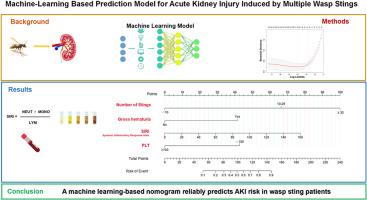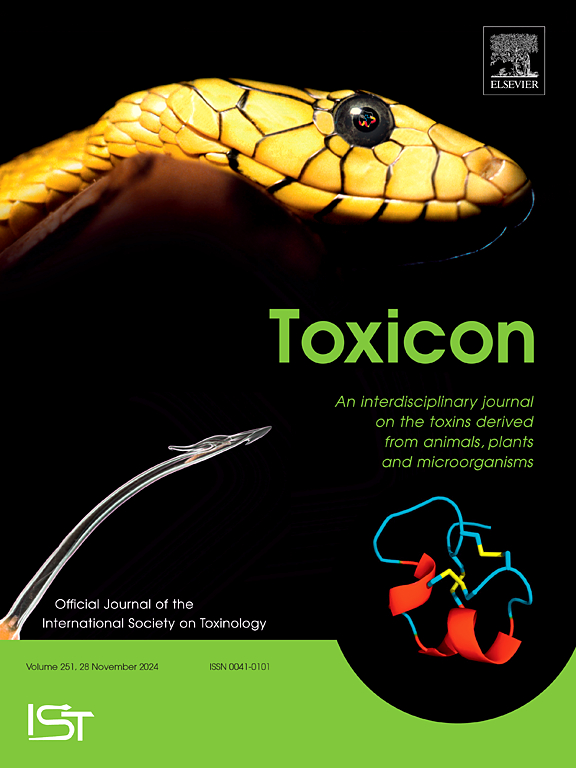Machine-learning based prediction model for acute kidney injury induced by multiple wasp stings
IF 2.6
4区 医学
Q2 PHARMACOLOGY & PHARMACY
引用次数: 0
Abstract
Acute kidney injury (AKI) following multiple wasp stings is a severe complication with potentially poor outcomes. Despite extensive research on AKI's risk factors, predictive models for wasp sting-related AKI are limited. This study aims to develop and validate a machine learning-based clinical prediction model for AKI in individuals with wasp stings. In this retrospective cohort study, conducted at a tertiary teaching hospital in Yichang, China, from July 2013 to April 2023, 214 patients with wasp sting injuries were analyzed. Using least absolute shrinkage and selection operator (LASSO) regression and multivariate logistic regression, prognostic variables for AKI were identified. A nomogram incorporating these four variables was constructed. The model's performance was assessed through internal validation, leave-one-out cross-validation, net reclassification improvement (NRI), integrated discrimination improvement (IDI), and decision curve analysis (DCA). Among 214 patients affected by wasp stings, 34.6% (74/214) developed AKI. Following LASSO regression and multivariate logistic regression, the number of stings, presence of gross hematuria, systemic inflammatory response index (SIRI), and platelet count were identified as prognostic factors. A nomogram was constructed and evaluated for its predictive accuracy, showing an area under the curve (AUC) of 0.757 (95% CI 0.711 to 0.804) and a concordance index (C-index) of 0.75. Validation confirmed the model's reliability and superior discrimination ability over existing models, as demonstrated by NRI, IDI, and DCA. The developed nomogram effectively predicts AKI risk in wasp sting patients, facilitating early identification and management of those at risk.

基于机器学习的多黄蜂蜇伤急性肾损伤预测模型
多次被黄蜂蜇伤后出现急性肾损伤(AKI)是一种严重的并发症,可能会导致不良后果。尽管对 AKI 的风险因素进行了广泛研究,但针对黄蜂蜇伤相关 AKI 的预测模型却很有限。本研究旨在开发并验证一种基于机器学习的临床预测模型,用于预测马蜂蜇伤患者的 AKI。这项回顾性队列研究于 2013 年 7 月至 2023 年 4 月在中国宜昌的一家三级教学医院进行,共分析了 214 名被马蜂蜇伤的患者。通过最小绝对收缩和选择算子(LASSO)回归和多变量逻辑回归,确定了AKI的预后变量。结合这四个变量构建了一个提名图。该模型的性能通过内部验证、留空交叉验证、净再分类改进(NRI)、综合判别改进(IDI)和决策曲线分析(DCA)进行了评估。在 214 名受黄蜂蜇伤的患者中,34.6%(74/214)发生了 AKI。经过 LASSO 回归和多变量逻辑回归,蜇伤次数、有无毛细血尿、全身炎症反应指数 (SIRI) 和血小板计数被确定为预后因素。该模型的曲线下面积 (AUC) 为 0.757(95% CI 0.711 至 0.804),一致性指数 (C-index) 为 0.75。NRI、IDI 和 DCA 的验证证实了该模型的可靠性和优于现有模型的辨别能力。所开发的提名图能有效预测马蜂蜇伤患者的 AKI 风险,有助于早期识别和管理高危人群。
本文章由计算机程序翻译,如有差异,请以英文原文为准。
求助全文
约1分钟内获得全文
求助全文
来源期刊

Toxicon
医学-毒理学
CiteScore
4.80
自引率
10.70%
发文量
358
审稿时长
68 days
期刊介绍:
Toxicon has an open access mirror Toxicon: X, sharing the same aims and scope, editorial team, submission system and rigorous peer review. An introductory offer Toxicon: X - full waiver of the Open Access fee.
Toxicon''s "aims and scope" are to publish:
-articles containing the results of original research on problems related to toxins derived from animals, plants and microorganisms
-papers on novel findings related to the chemical, pharmacological, toxicological, and immunological properties of natural toxins
-molecular biological studies of toxins and other genes from poisonous and venomous organisms that advance understanding of the role or function of toxins
-clinical observations on poisoning and envenoming where a new therapeutic principle has been proposed or a decidedly superior clinical result has been obtained.
-material on the use of toxins as tools in studying biological processes and material on subjects related to venom and antivenom problems.
-articles on the translational application of toxins, for example as drugs and insecticides
-epidemiological studies on envenoming or poisoning, so long as they highlight a previously unrecognised medical problem or provide insight into the prevention or medical treatment of envenoming or poisoning. Retrospective surveys of hospital records, especially those lacking species identification, will not be considered for publication. Properly designed prospective community-based surveys are strongly encouraged.
-articles describing well-known activities of venoms, such as antibacterial, anticancer, and analgesic activities of arachnid venoms, without any attempt to define the mechanism of action or purify the active component, will not be considered for publication in Toxicon.
-review articles on problems related to toxinology.
To encourage the exchange of ideas, sections of the journal may be devoted to Short Communications, Letters to the Editor and activities of the affiliated societies.
 求助内容:
求助内容: 应助结果提醒方式:
应助结果提醒方式:


